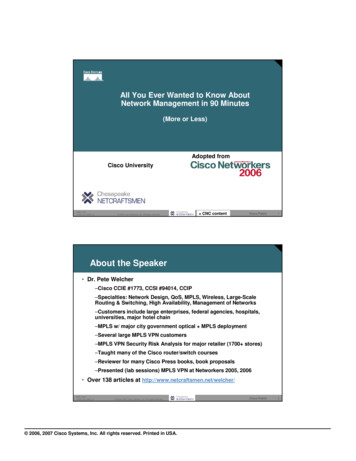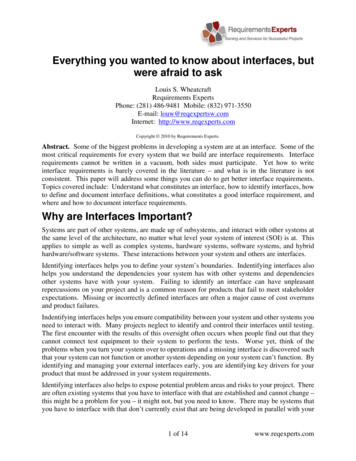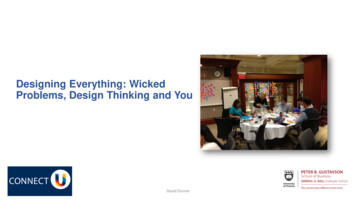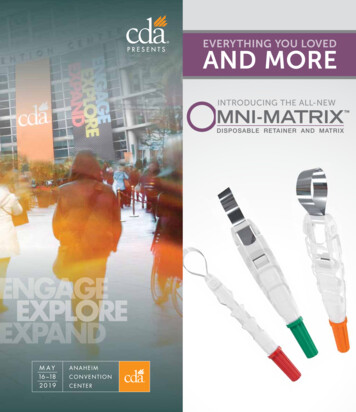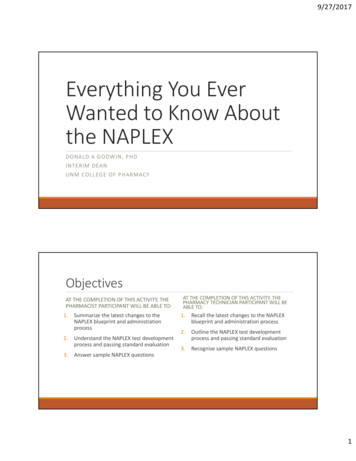
Transcription
9/27/2017Everything You EverWanted to Know Aboutthe NAPLEXD O N A L D A G O DW I N , P H DI N T ERIM D EA NU N M CO L L EG E O F P H A R M AC YObjectivesAT THE COMPLETION OF THIS ACTIVITY, THEPHARMACIST PARTICIPANT WILL BE ABLE TO:1.Summarize the latest changes to theNAPLEX blueprint and administrationprocess2.Understand the NAPLEX test developmentprocess and passing standard evaluation3.Answer sample NAPLEX questionsAT THE COMPLETION OF THIS ACTIVITY, THEPHARMACY TECHNICIAN PARTICIPANT WILL BEABLE TO:1.Recall the latest changes to the NAPLEXblueprint and administration process2.Outline the NAPLEX test developmentprocess and passing standard evaluation3.Recognize sample NAPLEX questions1
9/27/2017Financial DisclosureDonald Godwin, PhD, has no relevant financial relationships with commercial interests todisclose2
9/27/2017NAPLEX Blueprint – Area 1: Ensure Safe andEffective Pharmacotherapy and HealthOutcomes (Approximately 67% of Test)1.1 Obtain, Interpret, Assess, and/or Evaluate: 1.1.1 Information from patient interviews 1.1.2 Patient medical records 1.1.3 Results from instruments and screeningstrategies used to assess patients 1.1.4 Laboratory and diagnostic findings 1.1.5 Signs and symptoms associated with diseases andmedical conditions 1.1.6 Patients’ need for medical referral 1.1.7 Risk factors relevant to the prevention of adisease or medical condition and the maintenance ofwellness 1.1.8 Information from interdisciplinary health careproviders1.2 Develop and Implement Individualized Treatment Plans,Taking Into Consideration: 1.2.1 Specific uses and indications and dosing for drugs 1.2.2 Purported uses and indications for dietary supplements andcomplementary and alternative medicine 1.2.3 Lifestyle and self‐care therapy 1.2.4 Pharmacologic classes and characteristics of drugs 1.2.5 Actions and mechanisms of actions of drugs 1.2.6 The presence of pharmacotherapeutic duplications and/oromissions 1.2.7 Drug interactions 1.2.8 Contraindications, warnings, and precautions 1.2.9 Allergies 1.2.10 Adverse effects and drug‐induced illness 1.2.11 Pharmacodynamic, pharmacokinetic, and pharmacogenomicprinciples 1.2.12 Pharmacokinetic data to determine equivalence among drugproducts 1.2.13 Pharmacoeconomic factors 1.2.14 Routes and methods of administration, dosage forms, anddelivery systems3
9/27/2017NAPLEX Blueprint – Area 1: Ensure Safe and EffectivePharmacotherapy and Health Outcomes(Approximately 67% of Test)1.3 Assess and Modify IndividualizedTreatment Plans, Considering: 1.3.1 Therapeutic goals and outcomes1.3.2 Safety of therapy1.3.3 Efficacy of therapy1.3.4 Medication non‐adherence or misuse1.4. Techniques for EffectiveCommunication/Documentation of theDevelopment, Implementation, andAssessment of Individualized Treatment Plansto:1.5 Advocate Individual and Population‐BasedHealth and Safety, Considering: 1.5.1 Best practices, scientific literature evaluation,and health‐related resources 1.5.2 Quality improvement strategies in medication‐use systems 1.5.3 Processes, evaluation of, and responsesregarding medication errors 1.5.4 Role of automated systems and technology inmedication distribution processes 1.5.5 Emergency preparedness protocols 1.4.1 Patients and/or patients’ agents 1.4.2 Interdisciplinary health care providersNAPLEX Blueprint – Area 2 Safe and Accurate Preparation,Compounding, Dispensing, and Administration of Medications andProvision of Health Care Products (Approximately 33% of Test)2.1.0 Employ Various Techniques to Calculate: 2.1.1 Patients’ nutritional needs and the content of nutrientsources 2.1.2 Drug concentrations, ratio strengths, and/or extent ofionization 2.1.3 Quantities of medication to be compounded, dispensed, oradministered 2.1.4 Quantities of ingredients needed to compound preparations 2.1.5 Rates of administration2.3.0 Review, Dispense, and Administer Drugs and DrugProducts, Considering: 2.3.1 Packaging, labeling, storage, handling, and disposal ofmedications 2.3.2 Commercial availability, identification, and ingredientsof prescription and non‐prescription drugs 2.3.3 Physical attributes of drug products 2.3.4 Specific instructions and techniques for administration2.2.0 Compound Sterile and Nonsterile Products, Considering: 2.2.1 Techniques, procedures, and equipment for drug preparation,compounding, and administration of sterile products 2.2.2 Techniques, procedures, and equipment for drug preparation,compounding, and administration of nonsterile products 2.2.3 Physicochemical properties of active and inactive ingredients 2.2.4 Identifying the presence of, and the cause of, productincompatibilities or degradation and methods for achieving stability 2.2.5 Physiochemical properties of drugs that affect solubility andstability4
9/27/20175
9/27/20176
9/27/20177
9/27/201710090% Graduating Class8
9/27/20179
9/27/201710
9/27/2017Preparing COP graduates for the NAPLEXClass of 2015 and earlier Basically nothing on the COP’s part Library has a license with Exam Master and students were made aware ofNAPLEX review questions No monitoringClass of 2016 2 day live NAPLEX review course in late April Made students aware of library’s Exam Master licensePreparing COP graduates for the NAPLEXWe are not “teaching to the test”We are preparing the student to take the test11
9/27/2017Preparing COP graduates for the NAPLEXClass of 2017 Purchased COP specific Exam Master license Students were required to take a Baseline Assessment exam in January 2017 Students were required to take 5 different “topical” assessments in February and March 2017 Calculations and Compounding Review, Dispense, and Administer Drugs Pharmacotherapy and Health Outcomes Obtaining, Assessing, Communication and Advocacy Healthcare Information Faculty provided review sessions on questions the student body struggled with Students were required to take full‐length NAPLEX exam (6 hours, 250 questions) on April 26, 2017 Students were provided a different 2‐day, live NAPLEX review course (High Yield Med Reviews) on April 24and 25, 2017 Includes a very detailed review book.Preparing COP graduates for the NAPLEXClass of 2018 Exam Master NAPLEX review Students were required to take a Baseline Assessment exam in April 2017 Students will be required to take 5 different “topical” assessments between October 2017 and April 2018 (one each APPEblock)with faculty reviews Full‐length NAPLEX exam (6 hours, 250 questions) on May 7, 2018 Students will provided High Yield 2‐day, live NAPLEX review course on March 23 and 24, 2018 This year includes a 7 month training course of online lectures and review questions to prepare students for the live reviewcourse This year also has a full‐length practice exam12
9/27/2017Preparing COP graduates for the NAPLEXClass of 2019 Exam Master NAPLEX review Baseline exam in April 2018 Topical exams between October 2018 and April 2019 (one each APPE block) withfaculty reviews Full‐length NAPLEX exam (6 hours, 250 questions) in May 2019 Students will be provided the High Yield 2‐day, live NAPLEX review course(High Yield Med Reviews) on March 23 and 24, 2018 Students will get the course again in March 2019 after completing the 7 month online training programPreparing COP graduates for the NAPLEXClass of 2020 Everything previously listed plus a brand new curriculum13
9/27/2017A few practice NAPLEX questionsPractice question #1If a gallon of propylene glycol weighs 3,897.52 g at 25 C, what is the specific gravity ofpropylene glycol?A.1.23B.0.97C.1D.1.12E.1.0314
9/27/2017Practice question #2When differentiating Cushing syndrome and idiopathic Addison's disease, both can exhibitelevated levels of adrenocorticotropic hormone (ACTH). Additionally, Cushing's syndromeexhibits levels of cortisol and Addison's disease exhibits levels of cortisol.A.Cushing syndrome usually has a reduced level of ACTHB.Decreased; decreasedC.Decreased; elevatedD.Elevated; decreasedE.Elevated; elevatedPractice question #3What is the active ingredient in Rx #87562?What is the active ingredient in Rx #87562?A.IpratropiumA. IpratropiumB.AlbuterolB. AlbuterolC.LevalbuterolC.D.PirbuterolD. enol15
9/27/2017Practice question #4What interaction is important regarding Rx#217820?A.Concomitant use of an antihypertensivemay result in severe hypotensionB.Lithium carbonate may enhance itsstimulatory effectsC.It may counteract the sedative effect ofchlorpheniramineD.It may inhibit the action of warfarinE.Use with ascorbic acid may enhance itsgastric absorptionPractice question #5The patient’s physician prescribes zolpidem (Edluar) due to patient’s complaint on 4/18 (Patientpresents with c/o inability to fall asleep easily at night recently due to stress at work). What ofthe following best describes the drug’s dosage form?A.Inhaled solutionB.Intravenous solutionC.OintmentD.Sublingual tabletE.Transdermal patch16
9/27/2017Practice question #6What is the advantage of adenosine over calcium channel blockers in the treatment of acute AVnodal tachyarrhythmias?A.Greater effectivenessB.Shorter duration of actionC.Longer duration of actionD.Less expensiveE.Effective in atrial, AV nodal, and ventricular tachyarrhythmiasPractice question #7What clinical trial is designed to show that a treatment is no less effective than an quivalenceD.CohortE.Randomized17
9/27/2017Practice question #8A pharmacist receives a prescription for lactulose 4 tablespoonsful 3 times daily. How muchlactulose, in liters, would be dispensed for a 30 day supply?A.5.4B.10.8C.180D.5400E.10800Practice question #9What is the most effective tool to diagnose a patient with Parkinson's disease?A.Magnetic resonance imagingB.Unified Parkinson's Disease Rating Scale (UPDRS)C.Levodopa challengeD.Single photon emission computed tomographyE.Parkinson's Disease Questionnaire (PDQ‐39)18
9/27/2017Practice question #10Monitoring of complete blood count, platelet function tests, and serum amylase is associatedwith what eE.AtorvastatinPractice question #11A 63‐year‐old woman presents to the pharmacy asking for your advice. In the last week, shenoticed an increased difficulty sleeping and wakes up multiple times during the night due to“burning” in her stomach. Her medications include naproxen 550 mg twice daily, lisinopril 20 mgonce daily, alendronate 35 mg daily, and calcium 600 mg twice dailyA.Milk of MagnesiaB.Alka‐SeltzerC.Elevate her head while sleepingD.Prilosec OTCE.Refer to doctor for evaluation19
9/27/2017Practice question #12What is the generic name of the medicationprescribed on 8/14?A.Sulfamethoxazole and trimethoprimB.Amoxicillin and sulbactamC.Amoxicillin and clavulanate potassiumD.Ampicillin and clavulanate potassiumE.Ampicillin and flucloxacillinQuestions/Comments20
Full‐length NAPLEX exam (6 hours, 250 questions) on May 7, 2018 Students will provided High Yield 2‐day, live NAPLEX review course on March 23 and 24, 2018 This year includes a 7 month training course of online lectures and review questions to prepare students for the live review course


